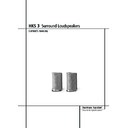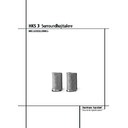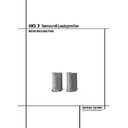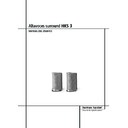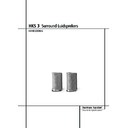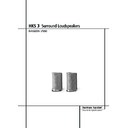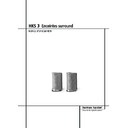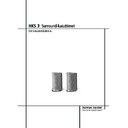Harman Kardon HKS 3 (serv.man2) User Manual / Operation Manual ▷ View online
MOUNTING OPTIONS 5
Wall-Mounting
Unscrew the bolt that attaches the black shelf
stand to the bottom of the speaker. Store the
stand and bolt in a safe place in case they are
needed for a future installation.
stand to the bottom of the speaker. Store the
stand and bolt in a safe place in case they are
needed for a future installation.
Mount the wall-bracket attachment plate on the
wall in the desired location.
wall in the desired location.
If possible, position the speakers so that the
mounting screws (not included; use size #8) may
be installed directly into a wooden wall stud.
If that is not possible, use optional wall anchors
that are rated to support at least twenty-five
pounds. The customer is responsible for
proper selection and use of mounting
hardware, available through hardware
stores, to properly and safely wall-mount
the speakers.
mounting screws (not included; use size #8) may
be installed directly into a wooden wall stud.
If that is not possible, use optional wall anchors
that are rated to support at least twenty-five
pounds. The customer is responsible for
proper selection and use of mounting
hardware, available through hardware
stores, to properly and safely wall-mount
the speakers.
Referring to the speaker connection instructions
on page 6, thread the appropriate speaker cable
through the opening in the bottom of the
attachment plate, and then through the back of
the bracket as shown in the diagram.
on page 6, thread the appropriate speaker cable
through the opening in the bottom of the
attachment plate, and then through the back of
the bracket as shown in the diagram.
The bracket has two openings on top: a round
screw hole, and an arc-shaped opening in front
of it. The speaker cable should be threaded
through the arc-shaped opening, not the screw
hole.
screw hole, and an arc-shaped opening in front
of it. The speaker cable should be threaded
through the arc-shaped opening, not the screw
hole.
Attach the bracket to the wall plate by inserting
the tab at the top of the attachment plate into
the slot on top of the bracket and snapping the
bracket onto the attachment plate.
the tab at the top of the attachment plate into
the slot on top of the bracket and snapping the
bracket onto the attachment plate.
Thread the cable through the round opening in
the terminal cover, and then insert the speaker
wires into the terminals on the underside of the
speaker, remembering to observe the correct
polarity (see page 6).
the terminal cover, and then insert the speaker
wires into the terminals on the underside of the
speaker, remembering to observe the correct
polarity (see page 6).
Place the terminal cover over the opening on the
underside of the speaker so that it fits flush
against the speaker and covers the terminals,
with its round opening exposing the threaded
insert. The bracket fits through the round open-
ing in the terminal cover.
underside of the speaker so that it fits flush
against the speaker and covers the terminals,
with its round opening exposing the threaded
insert. The bracket fits through the round open-
ing in the terminal cover.
Insert the supplied bracket bolt up through the
bottom of the bracket and terminal cover, and
screw it into the threaded insert on the under-
side of the speaker. The bolt should be snug, but
not so tight as to prevent the bracket from
pivoting.
bottom of the bracket and terminal cover, and
screw it into the threaded insert on the under-
side of the speaker. The bolt should be snug, but
not so tight as to prevent the bracket from
pivoting.
The wall-mounted speaker may be pivoted from
side to side; however, the bracket is not
designed to tilt up or down, and attempting to
tilt it will damage the bracket and possibly the
wall, which would not be covered by your war-
ranty.
side to side; however, the bracket is not
designed to tilt up or down, and attempting to
tilt it will damage the bracket and possibly the
wall, which would not be covered by your war-
ranty.
Wall
23mm
or 3/4"
or 3/4"
(M6–1.25P
or 1/4"–20)
or 1/4"–20)
Wall Bracket
Wires to Speaker
Terminal Cover
Overhead
View
Wire
From
Wall
Plate
From
Wall
Plate
Wall Plate
Remove
Stand
Stand
15mm
or 1/2"
Mounting Options
6 SPEAKER CONNECTIONS
Speaker Connections
Speaker-Level Connection Guide
IMPORTANT NOTE: Before making speaker
connections, be certain that your receiver or
audio power amplifier is turned off and prefer-
ably unplugged from its AC power source.
connections, be certain that your receiver or
audio power amplifier is turned off and prefer-
ably unplugged from its AC power source.
Speakers and electronics terminals have
corresponding (+) and (–) terminals. Most man-
ufacturers of speakers and electronics, including
Harman Kardon, use red to denote the (+)
terminal and black for the (–) terminal.
corresponding (+) and (–) terminals. Most man-
ufacturers of speakers and electronics, including
Harman Kardon, use red to denote the (+)
terminal and black for the (–) terminal.
Newer Harman Kardon receivers conform to the
CEA standard and therefore use a color other
than red or black for the (+) terminal to indicate
some speaker positions: e.g., blue for surround
left positive (+). However, the black terminal will
always be the negative (–) connection. Please
see the owner’s guide for your AVR Series receiv-
er for further details.
CEA standard and therefore use a color other
than red or black for the (+) terminal to indicate
some speaker positions: e.g., blue for surround
left positive (+). However, the black terminal will
always be the negative (–) connection. Please
see the owner’s guide for your AVR Series receiv-
er for further details.
Although the HKS 3 speakers may be placed in
the front, side surround or surround back posi-
tions, the speaker wires provided with the sys-
tem have been color-coded brown for the sur-
round back left speaker and tan for the surround
back right speaker. When used with the HKTS 7
system, it is recommended that you maintain the
color-coding system for all cables to simplify
setup, and to ensure that each wire in a channel
pair (e.g., front left and right) is the same length
as its partner.
the front, side surround or surround back posi-
tions, the speaker wires provided with the sys-
tem have been color-coded brown for the sur-
round back left speaker and tan for the surround
back right speaker. When used with the HKTS 7
system, it is recommended that you maintain the
color-coding system for all cables to simplify
setup, and to ensure that each wire in a channel
pair (e.g., front left and right) is the same length
as its partner.
The (+) lead of the speaker wire is indicated
with a stripe and has the colored band
corresponding to the speaker’s position. It is
important to connect all speakers identically: (+)
on the speaker to (+) on the amplifier and (–) on
the speaker to (–) on the amplifier. Wiring “out
of phase” results in thin sound, weak bass and a
poor stereo image.
with a stripe and has the colored band
corresponding to the speaker’s position. It is
important to connect all speakers identically: (+)
on the speaker to (+) on the amplifier and (–) on
the speaker to (–) on the amplifier. Wiring “out
of phase” results in thin sound, weak bass and a
poor stereo image.
With the advent of multichannel surround-sound
systems, connecting all of the speakers in your
system with the correct polarity remains equally
important in order to preserve the proper
ambience and directionality of the program
material.
systems, connecting all of the speakers in your
system with the correct polarity remains equally
important in order to preserve the proper
ambience and directionality of the program
material.
To connect the supplied speaker wires to the
satellite speaker terminals located on the bottom
of each speaker, press the red or black tab, insert
the bare end of the wire into the hole, and
release the tab. Gently tug on the wire to make
sure that it is fully inserted.
satellite speaker terminals located on the bottom
of each speaker, press the red or black tab, insert
the bare end of the wire into the hole, and
release the tab. Gently tug on the wire to make
sure that it is fully inserted.
Front-, Surround- or Surround Back-Channel
Receiver/Amplifier Output
Left
Right
+
–
+
–
– +
– +
Left Speaker
Right Speaker
Configuring Your Receiver or
Processor
Processor
Many receivers and processors feature program-
mable bass-management capability, which
allows the component to output the lowest fre-
quencies (the bass information) exclusively to a
separate subwoofer speaker, or to a main speak-
er that is capable of handling low frequencies, or
sometimes to both. During the setup process you
will be asked to specify whether the speaker for
a given channel is “Large” or “Small.” The terms
“Large” and “Small” do not refer to physical
size, but to the size of the frequency range the
speaker is capable of handling. When configur-
ing your receiver or processor for the channels
where HKS 3 speakers are being used, select
“Small.”
mable bass-management capability, which
allows the component to output the lowest fre-
quencies (the bass information) exclusively to a
separate subwoofer speaker, or to a main speak-
er that is capable of handling low frequencies, or
sometimes to both. During the setup process you
will be asked to specify whether the speaker for
a given channel is “Large” or “Small.” The terms
“Large” and “Small” do not refer to physical
size, but to the size of the frequency range the
speaker is capable of handling. When configur-
ing your receiver or processor for the channels
where HKS 3 speakers are being used, select
“Small.”
TROUBLESHOOTING 7
Troubleshooting
If there is no sound from
• Check that receiver/amplifier is on and a source is playing.
any of the speakers:
• Check all wires and connections between receiver/amplifier and speakers. Make sure all wires
are connected. Make sure none of the speaker wires are frayed, cut or punctured.
• Review proper operation of your receiver/amplifier.
If there is no sound coming
• Check the “Balance” control on your receiver/amplifier.
from one speaker:
• Check all wires and connections between receiver/ amplifier and speakers. Make sure all wires are
connected. Make sure none of the speaker wires are frayed, cut or punctured.
• In Dolby Digital or DTS
®
modes, make sure that the receiver/processor is configured so that the
speaker in question is enabled.
• In Dolby Digital or DTS mode, check the speaker and channel output levels and adjust if needed.
• Turn off all electronics and switch the speaker in question with one of the other speakers that
• Turn off all electronics and switch the speaker in question with one of the other speakers that
is working correctly. Turn everything back on, and determine whether the problem is in the
same place: i.e., the speaker that was working previously now has no sound and the speaker
that was not working now sounds fine; or whether it has moved: i.e., the speaker that was
not working still has no sound and the speaker that was working is still fine. If the problem is in
the same place, the source of the problem is most likely with your receiver or amplifier, and you
should consult the owner’s manual for that product for further information. If the problem has
followed the speaker, consult your dealer for further assistance or, if that is not possible,
visit our Web site at www.harmankardon.com for further information.
same place: i.e., the speaker that was working previously now has no sound and the speaker
that was not working now sounds fine; or whether it has moved: i.e., the speaker that was
not working still has no sound and the speaker that was working is still fine. If the problem is in
the same place, the source of the problem is most likely with your receiver or amplifier, and you
should consult the owner’s manual for that product for further information. If the problem has
followed the speaker, consult your dealer for further assistance or, if that is not possible,
visit our Web site at www.harmankardon.com for further information.
If the system plays at low volumes
• Check all wires and connections between receiver/ amplifier and speakers.
but shuts off as volume is
Make sure all wires are connected.
increased:
Make sure none of the speaker wires are frayed, cut or punctured.
• If more than one pair of main speakers is being used, check the minimum impedance
requirements of your receiver/amplifier.
If there is low (or no) bass
• Make sure the connections to the left and right “Speaker Inputs” have the correct polarity (+ and –).
output:
• Consider adding a powered subwoofer to your system.
If there is no sound from the
• Check all wires and connections between receiver/ amplifier and speakers.
surround speakers:
Make sure all wires are connected. Make sure none of the speaker wires are frayed,
cut or punctured.
• Review proper operation of your receiver/amplifier and its surround-sound features.
• Make sure the movie or TV show you are watching is recorded in a surround-sound mode.
• Make sure the movie or TV show you are watching is recorded in a surround-sound mode.
If it is not, check to see if your receiver/ amplifier has other surround modes you may use.
• In Dolby Digital or DTS
®
modes, make sure your receiver/processor is configured so that the
surround speakers are enabled.
• Review the operation of your DVD player and the jacket of your DVD to make sure that the
DVD features the desired Dolby Digital or DTS
®
mode, and that you have properly selected that
mode using both the DVD player’s menu and the DVD disc’s menu.
Specifications
Satellites
Recommended Power
10 – 80 Watts
10 – 80 Watts
Impedance
8 Ohms nominal
8 Ohms nominal
Frequency Response
110Hz – 20kHz (–6dB)
110Hz – 20kHz (–6dB)
Sensitivity
86dB @ 1 Watt/1 meter
86dB @ 1 Watt/1 meter
Tweeter
One 1/2" dome, video-shielded
One 1/2" dome, video-shielded
Midrange
One 3" driver, video-shielded
One 3" driver, video-shielded
Dimensions (H x W x D)
167mm x 100mm x 92mm
167mm x 100mm x 92mm
Weight
0.6kg
0.6kg
All features and specifications are subject to change without notice.
Harman Kardon and Power for the Digital Revolution are registered trademarks
of Harman International Industries, Incorporated.
of Harman International Industries, Incorporated.
* Trademarks of Dolby Laboratories.
DTS is a registered trademark of Digital Theater Systems, Inc.
250 Crossways Park Drive, Woodbury, New York 11797
www.harmankardon.com
Harman Consumer International:
2, Route de Tours, 72500 Château-du-Loir, France
© 2004 Harman Kardon, Incorporated
Part 406-000-05024
www.harmankardon.com
Harman Consumer International:
2, Route de Tours, 72500 Château-du-Loir, France
© 2004 Harman Kardon, Incorporated
Part 406-000-05024
Display

